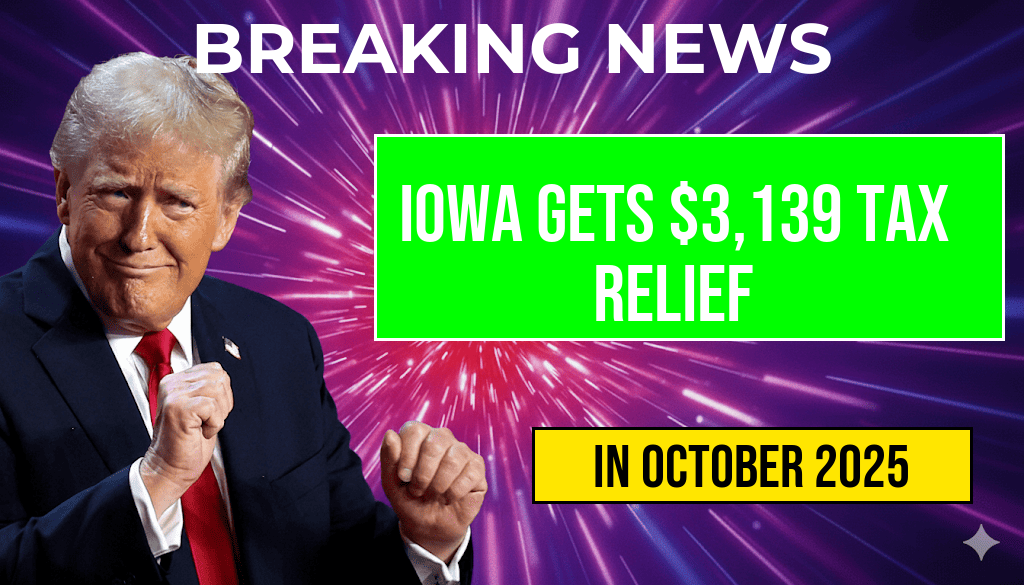Residents of Iowa are set to see a notable increase in their tax relief this year, with the state expected to benefit from the recent implementation of President Trump’s tax plan. According to official estimates, the average individual filer in Iowa will receive approximately $3,139 in tax relief, reflecting the broader national effort to reduce tax burdens and stimulate economic growth. This adjustment results from changes in federal tax policies that aim to lower rates, expand deductions, and simplify filing processes, providing direct financial benefits to taxpayers across the state. The relief is part of a larger initiative that has garnered both praise and critique at various levels of government and among economic analysts, emphasizing the plan’s focus on boosting disposable income for middle-income families and small businesses.
Details of the Tax Relief Breakdown for Iowa
How the $3,139 figure is calculated
| Category | Amount |
|---|---|
| Federal Tax Reduction | $2,500 |
| Increased Standard Deduction | $500 |
| Child and Family Credits | $139 |
| Total Estimated Relief | $3,139 |
This comprehensive figure encompasses federal adjustments that influence individual tax liabilities, including lower rates for middle-income brackets and expanded credits aimed at families with children. The calculations are based on the average taxpayer profile in Iowa, considering income levels, filing status, and eligible deductions as per the latest IRS data.
Impact on Iowa Households and Local Economy
The direct financial benefits are expected to enhance consumer spending, especially among middle-income families who constitute a significant portion of Iowa’s population. Economists suggest that increased disposable income can lead to higher spending on goods and services, potentially bolstering local businesses and supporting job creation. Small business owners, in particular, stand to benefit from the tax plan’s provisions that favor business deductions and incentives for capital investment.
Additionally, the relief is likely to influence state-level economic planning. State officials have expressed optimism that federal tax cuts will complement local efforts to improve infrastructure and public services, fostering a more robust economic environment. However, some critics caution that the benefits may disproportionately favor higher-income households or contribute to national budget deficits, raising concerns about long-term fiscal sustainability.
Political and Public Response
The announcement of tax relief figures has sparked a mixed response among Iowa’s political landscape. Supporters highlight the tangible benefits for families and small businesses, emphasizing the plan’s role in fostering economic growth. Forbes reports that local business associations have lauded the relief as a positive step towards economic recovery post-pandemic.
Opponents, however, argue that the tax plan favors wealthier Americans and increases federal deficits. Critics also question whether the relief will be enough to address ongoing economic disparities within the state. Iowa’s Democratic representatives have called for targeted measures to ensure that middle- and lower-income families see sustained benefits.
Looking Ahead: Federal and State Policy Interactions
The federal tax plan’s influence on Iowa is part of a broader national trend that intertwines federal and state fiscal policies. While the federal adjustments provide immediate relief, state governments remain responsible for implementing compatible policies that maximize benefits for residents. Iowa’s legislature is considering several proposals to extend or supplement federal tax benefits, including local deductions and credits tailored to regional economic needs.
For more information on the specifics of the federal tax plan and its broader implications, readers can consult the Wikipedia entry on the Tax Cuts and Jobs Act or visit the IRS official site for the latest updates.
As the tax season approaches, Iowa residents anticipate the tangible effects of federal reforms, with the $3,139 average relief serving as a tangible marker of the plan’s reach within the state’s economy and households.
Frequently Asked Questions
What is the amount of tax relief that Iowa will receive under Trump’s tax plan?
Iowa is set to receive a total of $3,139 in tax relief under Trump’s tax plan.
How will the tax relief impact Iowa residents and businesses?
The tax relief is expected to benefit residents and businesses by reducing their tax burdens, potentially leading to increased economic growth and more disposable income.
When will the tax relief funds be distributed to Iowa?
The distribution of the tax relief funds is anticipated to occur shortly after the implementation of Trump’s tax plan, with specific timelines determined by federal and state authorities.
Does this tax relief apply to all Iowa taxpayers?
The tax relief benefits may vary depending on individual tax situations, but generally, Iowa taxpayers will see some form of relief as outlined in the tax plan.
What are the main features of Trump’s tax plan that lead to this relief?
The main features include tax cuts for individuals and corporations, increased deductions, and reforms aimed at simplifying the tax code, all contributing to the tax relief allocated to Iowa.






